|
|
India, a country once called the golden bird because of the abundance of the gold and the asset-richness, which made it a very lucrative destination for scholars and traders, is now attracting global attention for an all-new reason – the thriving start-up ecosystem.
The innovation timeline of India has been impressive right from the techniques in plastic surgery in the times of Sushruta to the modern-day Mars mission. However, fear of failures and lack of funding snubbed the dreams of many potential entrepreneurs.
This image of a conservative and risk-averse nation has taken time to undergo change, and now India is making significant strides in the start-up space. Let us delve into the current state of the start-up ecosystem in India and the various factors that are enabling the expansion.
A start-up is “An entity, incorporated in last five years, working towards innovation, development, deployment, and commercialization of new products, processes, or services driven by technology or intellectual property.”
2019 edition of annual NASSCOM – Zinnov report on ‘Indian Tech Start-up ecosystem’
The present scenario of the Indian start-up ecosystem looks very promising and the following numbers substantiate it.
According to the NASSCOM-Zinnov report on ‘Indian Tech Start-up ecosystem’, a staggering number of 8900-9300 start-ups have been incepted during the years 2014-2019, with the overall number of start-ups growing at a rate of 12–15% year on year.
The start-up base has been exhibiting steady and sustained growth and has seen an addition of more than 13001 start-ups in 2019, out of which 43%1 operate in the B2B space.
With Angel Investors, Venture Capitalists, Private Equity firms, and institutional investors actively funding start-ups, the total equity funding that these start-ups have received has touched a staggering USD 5.97 Bn as of November 2019.
Contributing significantly to solve for unemployment, which is a pressing issue, these start-ups pumped in more than 60,0001 direct jobs and 1.3-1.8 Lakh new indirect jobs into the economy in the year 2019.
The following image presents a snapshot of the current state of the start-up ecosystem in India.
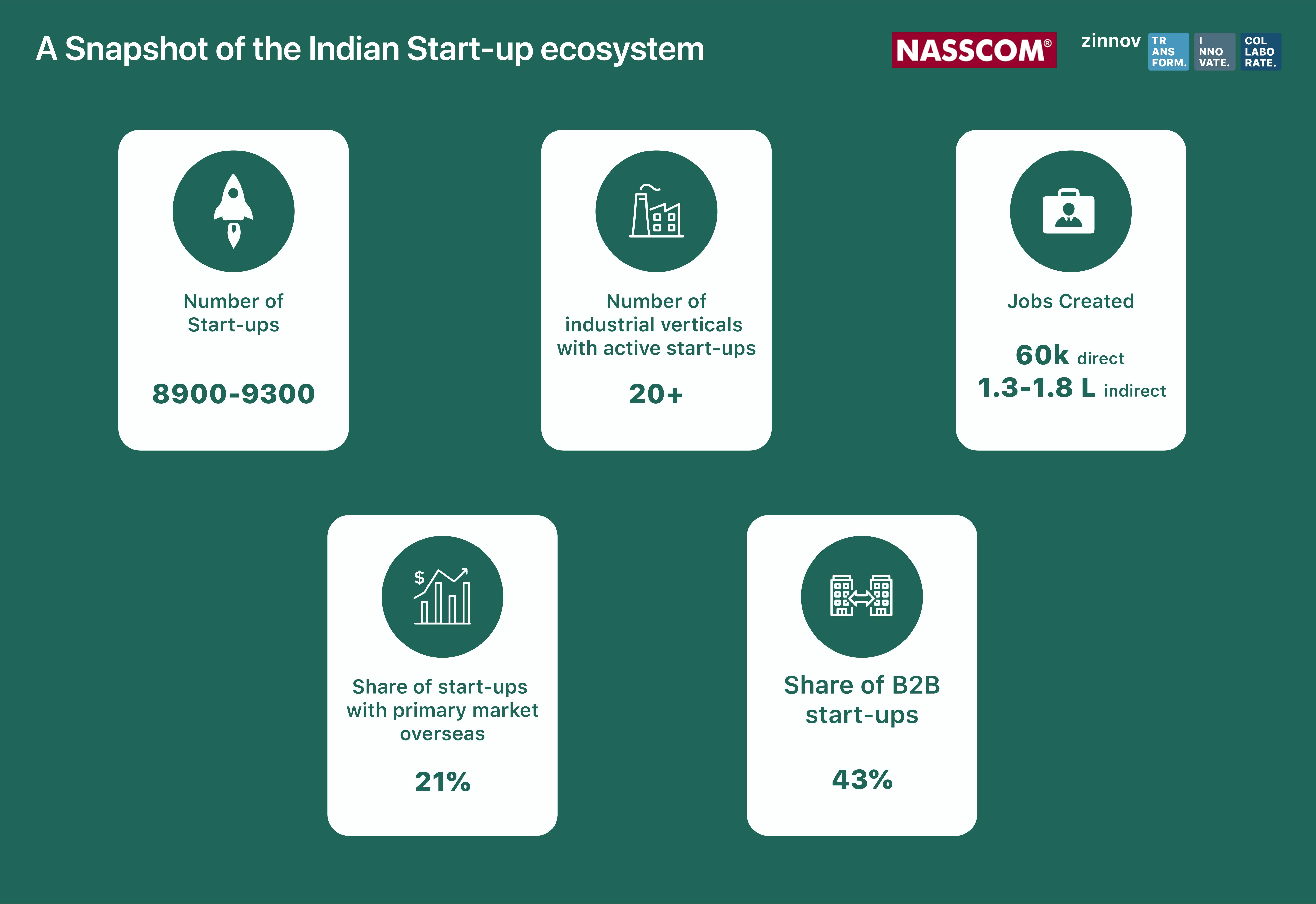
‘Unicorn’ – A term that once painted a mystical image of a one-horned equine now conjures an image of a coffee mug, a funky workspace and people bustling around, making millions, in fact – Billions.
The year 2019 has been a phenomenal year for the Indian unicorns with respect to parameters such as the number of new unicorns, unicorns in new businesses, the average time to unicorn, etc.
The number of unicorns has gone up to a whopping 261 with 91 new start-ups making their way to the prestigious Billion-dollar club. These start-ups include BigBasket, Delhivery, Dream11, Druva, Icertis, Lenskart, Ola Electric, RIVIGO, and Zerodha. These start-ups have had their genesis in five Indian cities that include Pune, Bangalore, Mumbai, Delhi, and Gurgaon.
55%1of the new entrants are the ones that had ventured into the B2B space which is the highest ever in a year. This has contributed significantly to the surge in the overall percentage of unicorns operating in B2B, which currently stands at 44%1.
The average time taken for an Indian unicorn to make it to the club has been 6-8 years which is similar to other Top 5 largest start-up ecosystems in the world, including the United States of America.
The Indian unicorn club now has companies in gaming, supply chain and logistics, e-mobility in addition to the conventional ones like e-commerce and mobility.
The start-ups founded in 2014-19 are scaling faster than their older peers and constitute approximately 41% of the total pool of all companies with greater than $50Mn1 in cumulative funding. More than 351 start-ups have made it to the pool of potential unicorns.
The following image is a snapshot that encompasses the critical indicators that reflect the growth of unicorns in India.
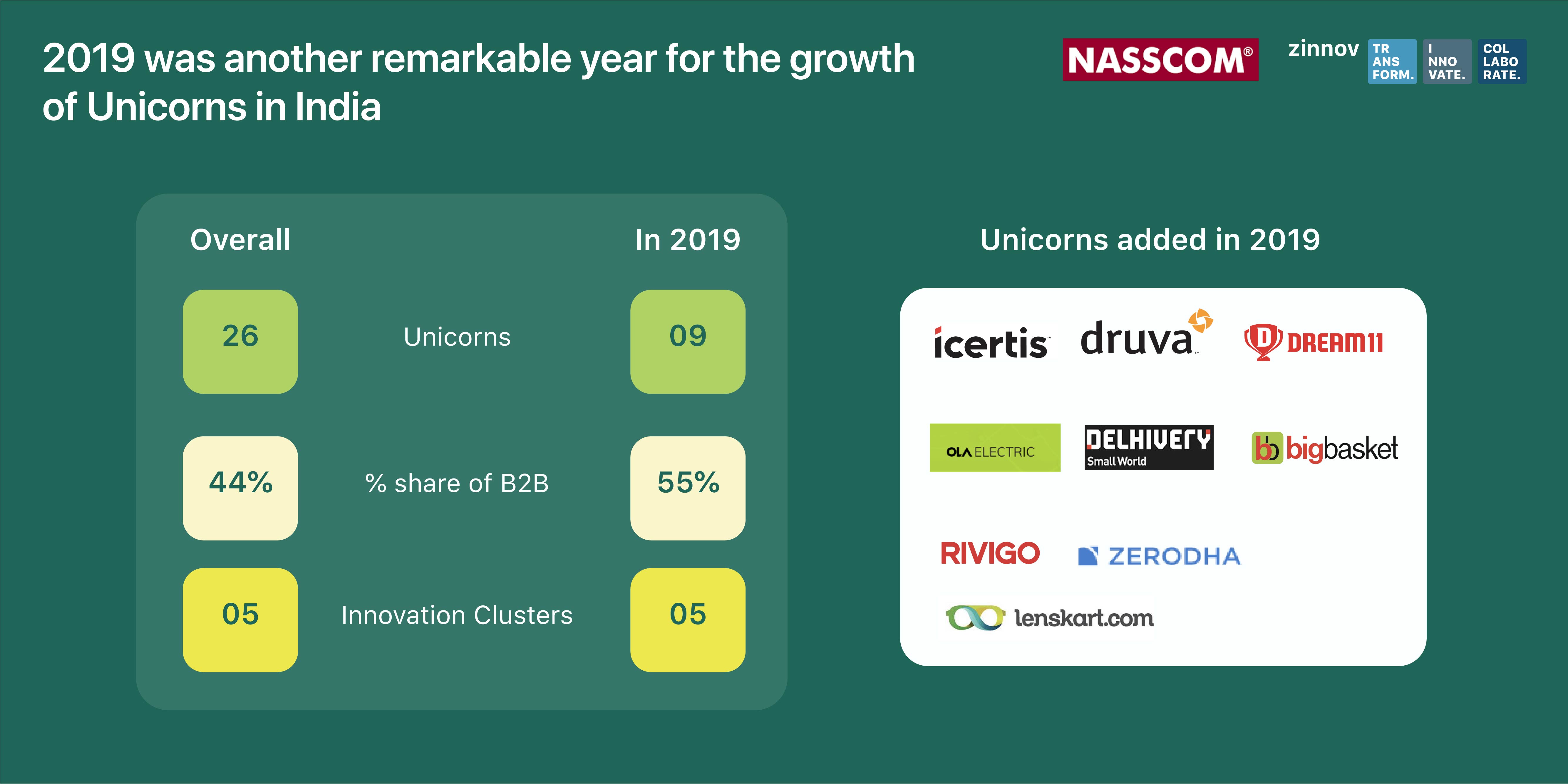
With the burgeoning unicorns, and start-ups overall, the industry sectors in which the start-ups predominantly operate, their levels of maturity, etc. are other intriguing areas that require attention.
Diversity in industry sectors and use cases reflect the strength of an ecosystem. There is continued expansion in industries targeted by Indian start-ups and a significant improvement in the quality of use cases that are being solved for. The following segment talks about the categorization of sectors according to their maturity, which is determined based on three factors:
• Unfunded and funded start-up base: A sum of both the funded and unfunded start-ups operating in the industry sector
• Adoption of Deep Tech: Adoption of technology like AI/ML, IoT, Big Data & Analytics, Blockchain, AR/VR, etc.
• Investor Activity: The total investments and funding attracted by an industry sector
These are sectors with a large unfunded and funded start-up base with high adoption of deep-tech and investor activity. FinTech, Enterprise, Healthtech, Retail & Retail Tech are the sectors that are the most mature1 sectors with strong metrics across the dimensions of Maturity Index and Investment Index.
Supply Chain Management & Logistics, Mobility, Real Estate & Construction, Travel & Hospitality, EdTech, and Media & Entertainment are the
emerging1 sectors1 with medium unfunded and funded start-up base with relatively low-to-high adoption of deep-tech and medium-to-high investor activity.
Human Resources, Energy and utilities, Agritech, Aerospace & Defense, and Industrial Manufacturing are the nascent1 sectors with a small start-up base and hence relatively lower investor activity.
The following graph indicates the healthy mix of sectors at varying maturity levels.
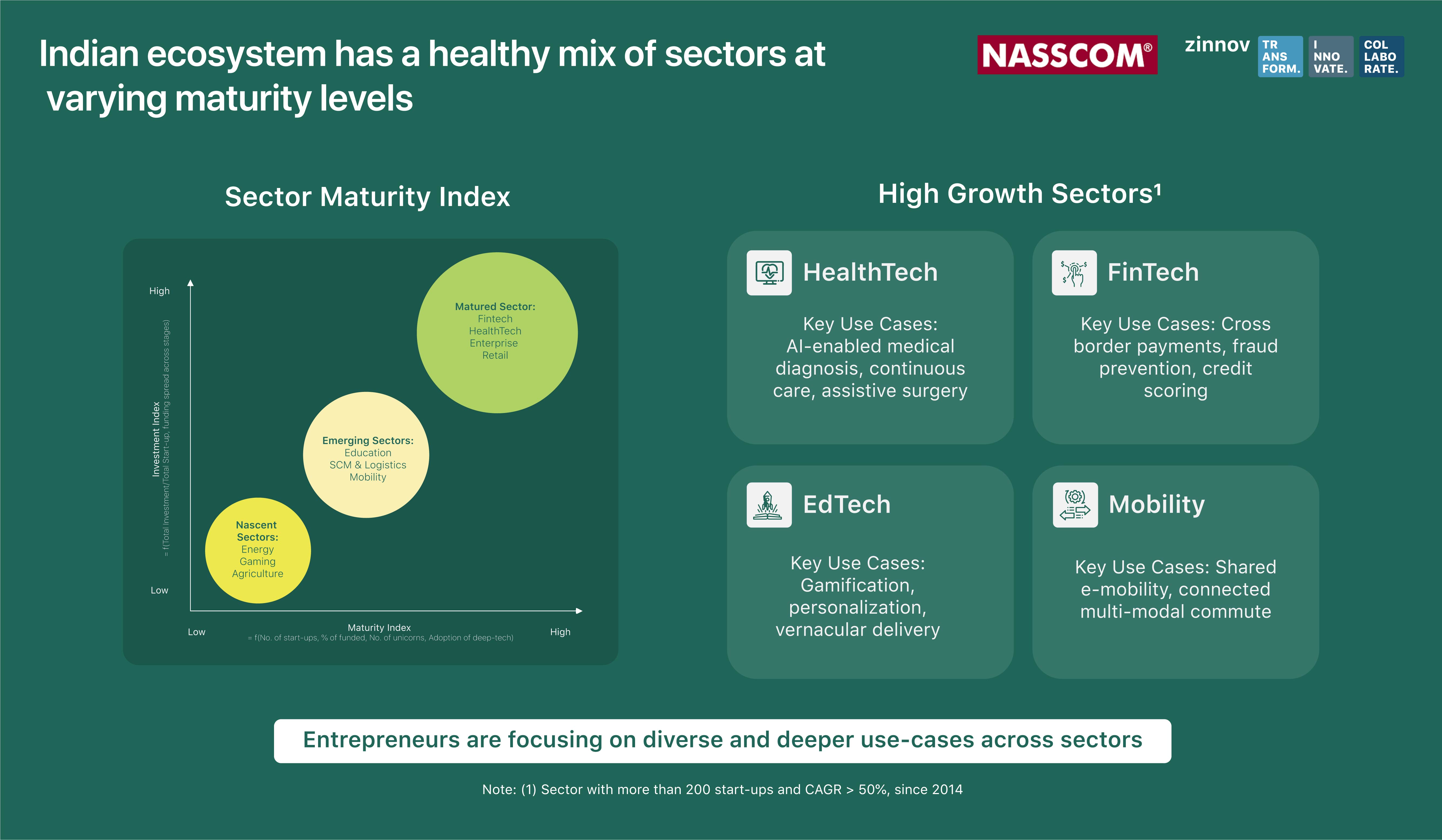
One critical component with respect to sector maturity, which is evident from the above graph is the adoption of Deep Tech. So, what is the growth rate of the start-up pool that is extensively leveraging Deep Tech? Here are some key facts and figures:
There are more than 16001 start-ups that operate in the Deep Tech space, and the Deep-Tech start-up pool has grown at a staggering CAGR of 40% since 20141.
AI leads the race!
The start-ups that operate in the AI space account for 27%1 of the Deep Tech start-ups and lead the race. It is followed by IOT, Big Data & Analytics, Blockchain, AR/VR, Drones, and others.
The following image is a snapshot of the percentage-wise breakup with respect to the technology the Deep Tech start-ups engage in, and their key application areas.
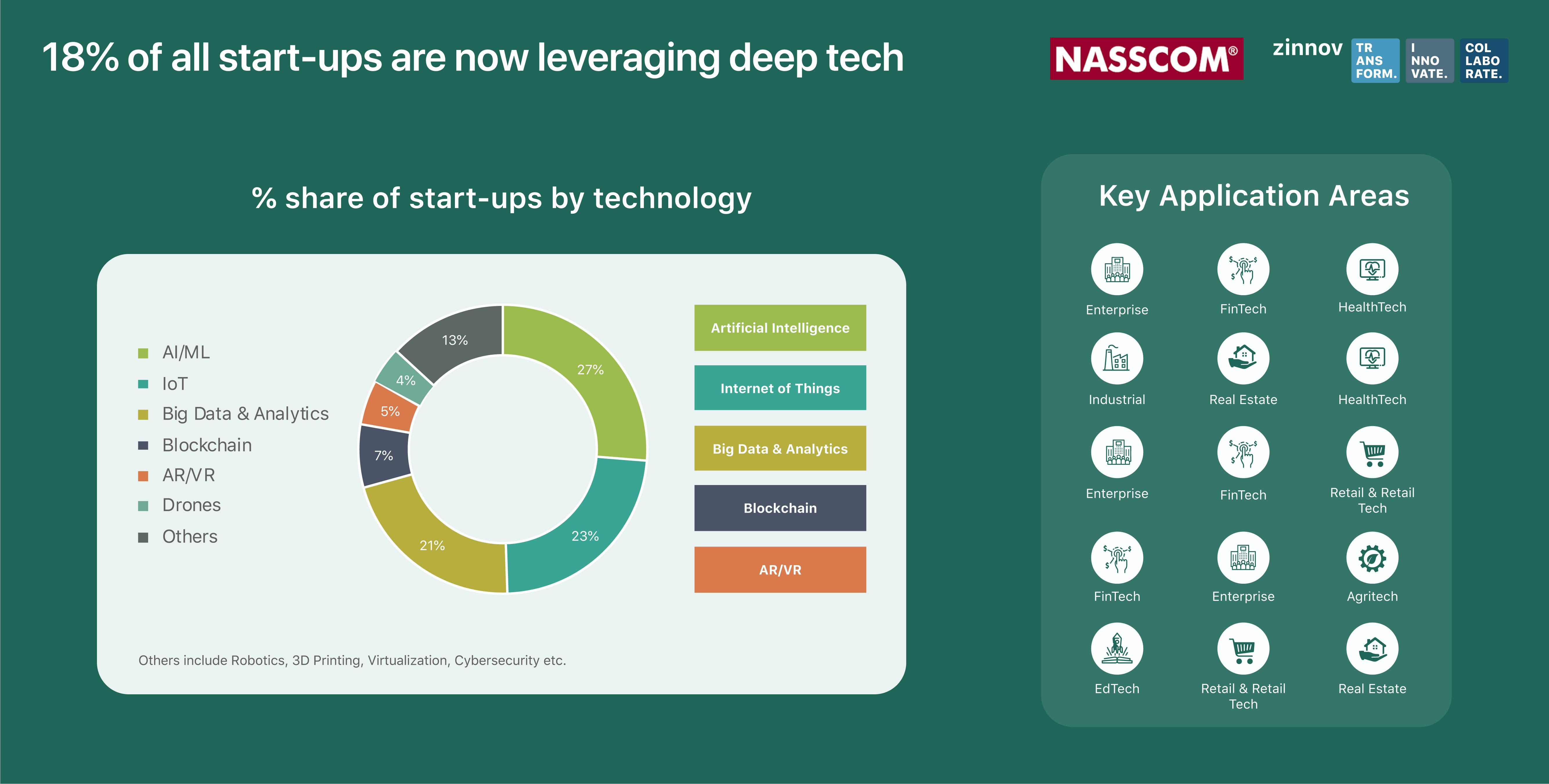
Evidently the future of Deep Tech Indian start-ups is promising. But are the Indian start-ups building global products and addressing international markets? The following segment will answer that.
Globalization is a phenomenon that is greatly catching up as far as the Indian start-up ecosystem is concerned. There are primarily two categories of start-ups in this segment.
About 21% of Indian start-ups with headquarters in India are focused on global markets. The number of such start-ups has gone up to a 1900+ in 2019 as compared to a 1600+ in 2018, which is a significant 18% growth. Speaking of the composition of such start-ups, 70% of them operate in the B2B space. An example of an Indian start-up headquartered in India but targeting global customers is, MoEngage which is an AI-driven omnichannel marketing platform leveraged by Enterprises in 35 countries2. Other examples include Innovaccer, ToneTag, Intellicar, Vue.ai, etc.
More than 480 start-ups with a non-Indian HQ have their centers in India and are building global products; it is a 14% increase from the number in 2018. An interesting fact about the composition of the start-ups in this category is that, more than 20 of them are unicorns with their R&D centers in India. Examples of US-based unicorns with R&D centers in Bangalore are JFrog, a universal Artifact Repository manager, and Cohesity, focused on database management.
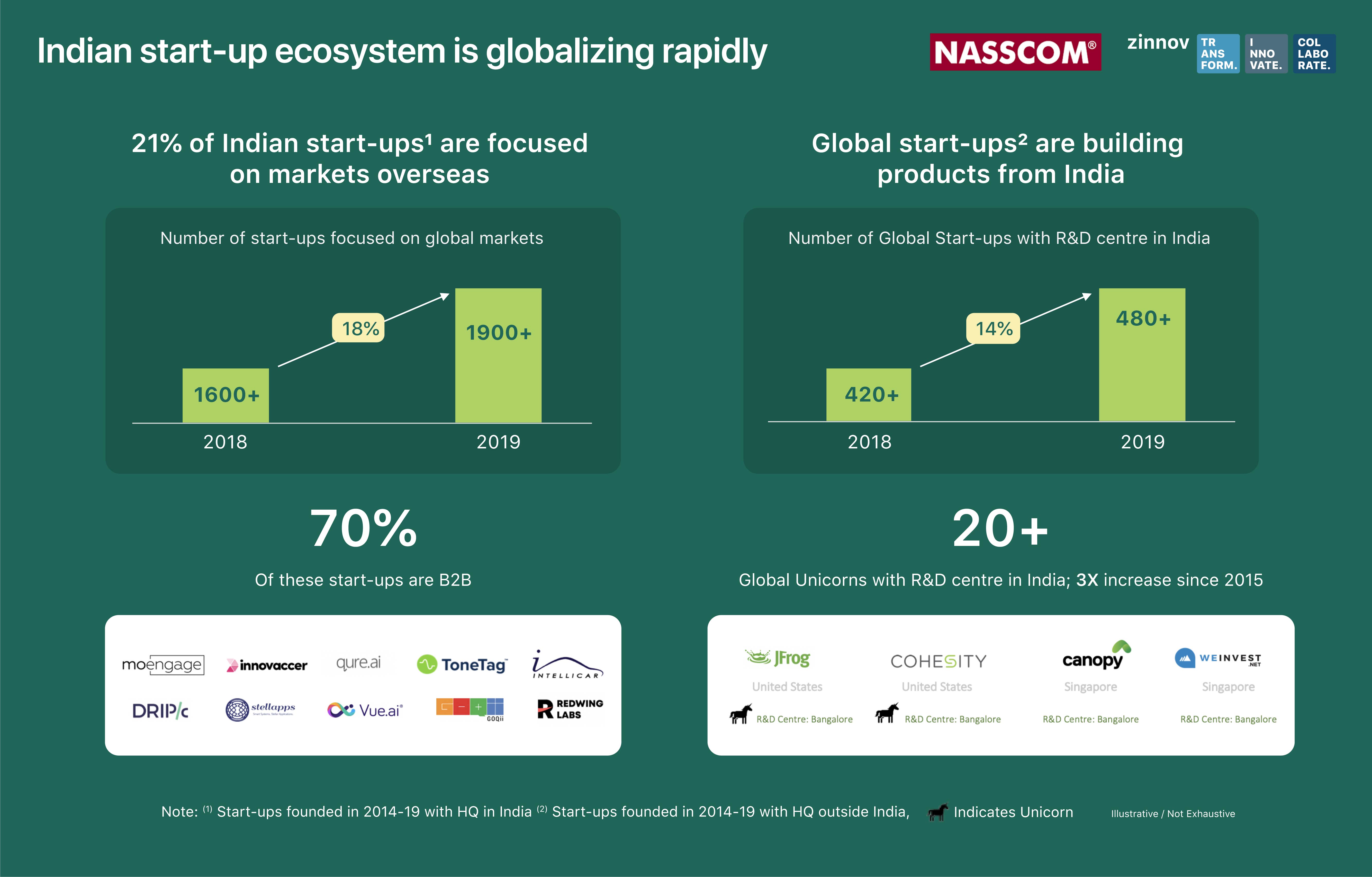
A globalized ecosystem is enabling expansion of opportunities for Indian talent and entrepreneurs, and hence the increase in the number of global start-ups is clearly a positive trend.
The Indian start-up landscape is a rapidly expanding one and offers great potential for a catalyzed growth of up to 4X by 20251 by adopting measures like enabling revenue generation, increasing corporate participation, and seed-stage investments, and by strengthening the support ecosystem.
India is truly a land of burgeoning ideas; a quirky start-up story to support that statement. ‘Janampatri’ is the horoscope that depicts the planetary positions during the time of a person’s birth, and purportedly predicts a person’s health, wealth, career, etc. Capitalizing on this belief of predicting a person’s health, serial Entrepreneur Anu Acharya, came up with a DNA-based preventive health assessment product called ‘GenomePatri’!
Another story is that of a bunch of three youngsters living in the lanes of Arikere, Bangalore identified a problem statement faced by small businesses that they regularly transacted with – Bookkeeping! OKCredit, a FinTech start-up that facilitates digitized bookkeeping for small businesses was thence born, based on the concepts of Udhaar and Jama which mean ‘borrowing’ and ‘depositing’ respectively3.
Brimming with several innovation stories of this kind, and with the confluence of various elements of the ecosystem conducive to innovation, India is progressing significantly with respect to its start-up landscape.
References: